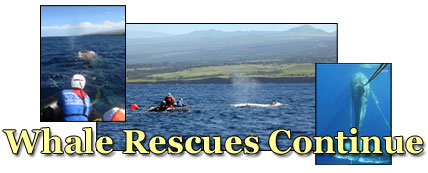
By Briana Langford
This February, a call came in to the Hawaiian Islands Disentanglement Network about a distressed whale off Hawai‘i’s Big Island. Coordinators David Mattila and Ed Lyman from the Hawaiian Islands Humpback Whale National Marine Sanctuary and their team successfully freed the whale, but the outlook is still grim for the animal. “The whale was thin, light colored, and covered with a carpet of whale lice. These are indications of poor health, most likely caused by the entanglement,” Lyman said. This event is an example of the troubling situation that is unfolding in and outside sanctuary waters.
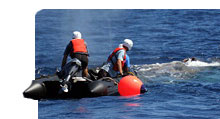 |
 |
|
|
The Importance of the Whale Rescue
Thus far, 2007 is shaping up to be a busy season for whale rescue attempts in Hawaiian waters. The Whale Disentanglement Network, coordinated by David Matilla and Ed Lyman from the Humpback Whale National Marine Sanctuary, has already received reports of 7 entangled humpback whales. This matches the total for the entire season in 2006. Four of these animals were successfully freed by Disentanglement Network personnel and another whale even managed to liberate itself from the gear. Contact was lost with the other two whales before a rescue attempt could be made.
The first whale was successfully freed in early February after a call came in to the Hawaiian Islands Disentanglement Network about a distressed whale off Hawai'i's Big Island. The animal had fishing gear trailing from both sides of its mouth and lines that pinned the left flipper to its body and trailed 40 feet behind it. The animal's condition was deemed life threatening. Mattila, Lyman and their team rushed to the scene and successfully freed the whale.
Just a few short weeks after the first rescue, a whale with gear running through its mouth was spotted by tour boats off the shore of Lahaina, Maui. After an immediate response from the Whale Disentanglement Network, the animal was completely freed from the gear. Another rescue was made at the end of February after a whale was discovered with fishing gear wrapped around the base of its tail. In the beginning of March, another animal was freed from fishing gear that was running through its mouth. Because of the efforts of the rescue team and the community, these four whales have been given a chance to survive.
For some of the freed whales the outlook is still grim. "Two of the entangled whales were thin, light colored, and covered with a carpet of whale lice. These are all indications of poor health, most likely caused by the entanglement," Lyman said. These entanglements are just examples of the troubling situation that is unfolding in and outside sanctuary waters.
Due to heightened vigilance and better monitoring techniques, many whales from outside Hawaii have already been successfully disentangled this year. In January, a rare right whale was spotted off the coast of Georgia with fishing lines and corroding hooks dangling from its mouth. After an exhausting eight-day pursuit up the east coast, conditions where finally favorable and the animal was freed from the fishing gear by trained personal with the Atlantic Large Disentanglement Network and NOAA off the coast of North Carolina. Right whales are particularly vulnerable to entanglement in fishing gear and other marine debris because they travel close to the coast.
NOAA personal and their partners around the country will continue their vigilance as the busy summer whale watching season approaches. Hopefully, the success so far in 2007 will continue for any whale that is in need of assistance.
|
|
Marine mammals getting caught in fishing gear and debris is a serious and growing concern. Entanglement can lead to drowning, starvation or infection. Each year, hundreds of thousands of whales and dolphins die from entanglement in fishing gear, which is the number one human-related cause of mortality.
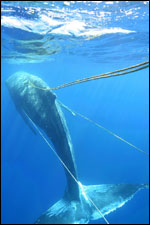 | | Entangled Whale (permit #932-1489-08) |
The whales that have been freed in Hawai’i this year builds upon the hard work from 2006. These rescues are a result of a dedicated group of people that make up Hawaiian Islands Disentanglement Network. “Though an entangled whale can be difficult to work with, the animal can be saved,” said Lyman. In February 2006 off the north side of the island of Lana‘i, a humpback whale caught in 100 feet of gear originating from Kodiak, Alaska was successfully freed. Another whale was freed later that year by network members.
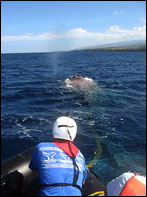 | | Viezbicke holding position behind whale. (permit #932-1489-08) |
To heighten vigilance and rescue efforts, the network has trained more first responders this year that assist with locating the entangled whales and documenting the event. The network has also invested in more equipment, such as cameras attached to the ends of poles that are used to monitor the animal while keeping the people safely on board. The biggest improvement has been the acquisition of four hi-tech transmitters and two others that are on loan from the Alaska NOAA Fisheries Office.
“Attaching transmitters to the gear ensnaring the whale allows the rescue team to track the animal until proper equipment and trained personnel have been assembled, and conditions are favorable to safely cut the whale free,” says Mattila.
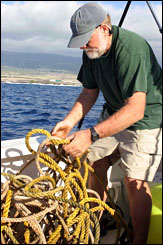 | | David Mattila, Science and Rescue Coordinator for HIHWNMS, investigates some of the gear removed from the animal. (permit #932-1489-08) |
While cutting free an entangled animal may save the animal, preventing entanglement is the ultimate solution. Among the numerous marine debris removal efforts around the sanctuaries in 2006, the sanctuary program partially funded Hawai‘i Wildlife Fund volunteers to remove 42 tons of marine debris from Waiohinu-Ka Lae coast of Hawai‘i’s Big Island and divers have removed approximately 511 metric tons from the Northwestern Hawaiian Islands since 1997.
Whales are not only being freed in Hawai’i. In Stellwagen Bank National Marine Sanctuary, several whales were rescued in 2006. In July, a whale was spotted with netting and rope streaming from its mouth. The whale was successfully liberated from the gear with the help of the Provincetown Center for Coastal Studies. Two more whales were successfully freed by sanctuary staff in Stellwagen Bank later that summer. With heightened vigilance, better equipment, and a dedicated staff, these whales have been given a chance to survive.
NOAA staff and our partners are continuing their vigilance this year to come to the aid of any whale that is entangled in marine debris. The public is strongly encouraged to properly dispose of all trash and anyone who sees an entangled whale or other marine mammal should call the local NOAA Fisheries Regional Office, Marine Mammal Stranding Network, or the U.S. Coast Guard.
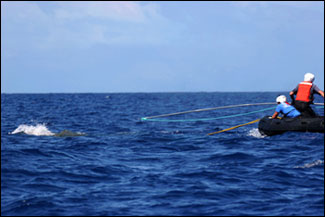 | | HIDN team uses a hooked knife that will disengage from a pole to cut a tight wrap of line around the animal. (permit #932-1489-08) |
|



